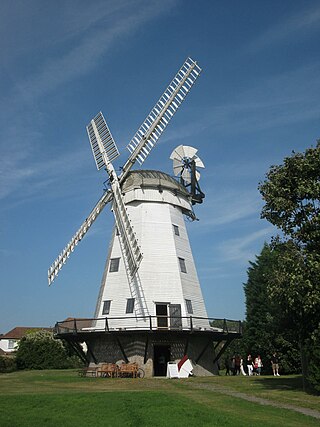
Upminster Windmill is a Grade II* listed smock mill located in Upminster in the London Borough of Havering, England. It was formerly known as Abraham's Mill and was in Essex when built. It has been restored and is a museum open to the public at selected times.

Stocks Mill is a Grade II* listed post mill in Wittersham on the Isle of Oxney, in Kent, England which has been preserved.

Durrington or High Salvington Windmill is a Grade II listed post mill in High Salvington, Sussex that has been restored and is in full working order. The mill stands 320 feet (98 m) above sea level and is able to take advantage of incoming sea winds.

Outwood Windmill is a Grade I listed post mill in Outwood, Surrey. Built in 1665 by Thomas Budgen, a miller from Nutfield in Surrey, it is Britain's oldest working windmill.
The Clayton Windmills, known locally as Jack and Jill, stand on the South Downs above the village of Clayton, West Sussex, England. They comprise a post mill and a tower mill, and the roundhouse of a former post mill. All three are Grade II* listed buildings.

Oldland Windmill is an 18th-century post mill situated near the village of Keymer, West Sussex, England.

Herne Windmill is a Grade I listed smock mill in Herne, Kent, England, that was built in 1789.

Davison's Mill, also known as Stelling Minnis Windmill, is a Grade I listed smock mill in Stelling Minnis, Kent, England that was built in 1866. It was the last windmill working commercially in Kent when it closed in the autumn of 1970.
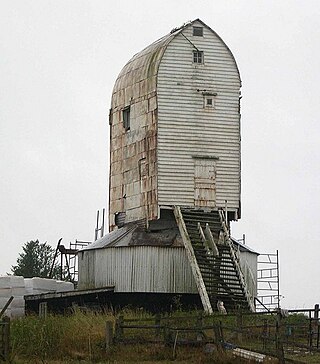
New Mill is a Grade II* listed post mill at Cross in Hand near Heathfield, East Sussex, England. It was the last windmill working commercially by wind in Sussex, ceasing work by wind in 1969 when a stock broke.
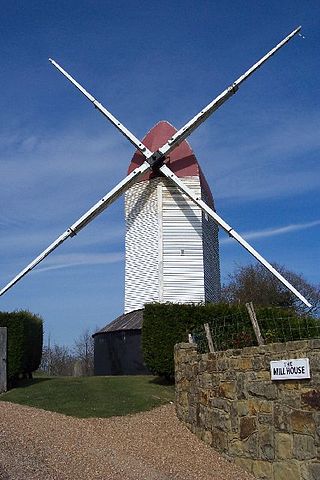
Argos Hill Mill is a grade II* listed post mill at Argos Hill, Mayfield, East Sussex, England

Stone Cross Windmill is a grade II* listed tower mill at Stone Cross, Sussex, England which has been restored and is open to the public. The mill was also known as Blackness Mill and the White Mill.
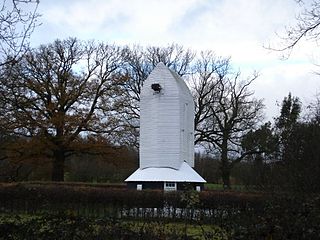
Lowfield Heath Windmill is a grade II listed post mill at Charlwood, Surrey, England which has been restored to working order.

Reigate Heath Windmill is a grade II* listed post mill at Reigate Heath, Surrey, England which has been restored and is used as a chapel. It is thought to be the only windmill in the world which is a consecrated church.

Shiremark Mill, also known as Kingsfold Mill or Capel Mill was a listed Smock mill at Capel, Surrey, England, which was burnt down in 1972.
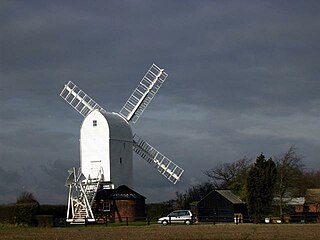
Aythorpe Roding Windmill is a Grade II* listed Post mill at Aythorpe Roding, Essex, England which has been restored to working order.

Mountnessing Windmill is a grade II* listed post mill at Mountnessing, Essex, England. Built in 1807, it was most recently restored to working order in 1983.

Ramsey Windmill is a grade II* listed post mill at Ramsey, Essex, England which has been restored.

Stansted Mountfitchet Windmill is a grade II* listed Tower mill at Stansted Mountfitchet, Essex, England which is also a Scheduled Ancient Monument. It has been restored and can turn by wind.

Framsden Windmill is a Grade II* listed post mill at Framsden, Suffolk, England which is preserved. The mill was known as Webster's Mill when it was a working mill.

Cromer Windmill, restored in four stages between 1967 and 1998, is a Grade II* listed post mill at Cromer, Ardeley, Hertfordshire, England.





















